
In recent years, the concept of regenerative gardening has gained significant traction among eco-conscious homeowners and small-scale farmers alike. This holistic approach to cultivating your green spaces mimics natural ecosystems, prioritizing soil health, biodiversity, and sustainable resource management. As an educator at Crooked Pines Farm, I’m excited to share how you can implement these transformative techniques in your own backyard or patio garden.
Soil Health Strategies
At the heart of regenerative gardening lies the fundamental principle of nurturing the soil. After all, healthy plants rely on a vibrant underground ecosystem teeming with microbial life. Let’s explore some key strategies to revitalize your garden’s foundation.
Composting Techniques
One of the most effective ways to enrich your soil is through composting. Rather than disposing of yard waste and kitchen scraps, create a nutrient-dense compost pile that can be regularly incorporated into your garden beds. This organic matter not only adds essential nutrients but also improves soil structure, enhancing water retention and aeration. Spread a 1-3 inch layer of compost over your planting areas in the fall or spring for best results.
Cover Cropping Benefits
Cover cropping is another valuable tool in the regenerative gardener’s arsenal. These low-growing plants, such as legumes or grasses, can be sown between growing seasons to suppress weeds, prevent soil erosion, and replenish key nutrients like nitrogen. When the time comes to plant your vegetables or flowers, simply cut down the cover crop and allow the decomposing vegetation to enrich the soil.
Nutrient Cycling Importance
Recognizing the importance of nutrient cycling is crucial. Rather than removing all plant matter at the end of the season, consider leaving some roots and stems in the ground. As these materials break down, they’ll feed the microorganisms that are essential to soil health. Additionally, using organic, slow-release fertilizers can provide a steady supply of nutrients without disrupting the delicate balance of the soil ecosystem.
Biodiversity Enhancements
Promoting biodiversity is a fundamental tenet of regenerative gardening. By cultivating a diverse array of plant life and providing habitats for beneficial insects and wildlife, you can create a thriving, self-sustaining ecosystem right in your own backyard.
Native Plant Selection
When selecting plants for your garden, prioritize native species that are well-suited to your local climate and soil conditions. These resilient plants not only require fewer resources to thrive but also provide essential food and shelter for pollinators and other wildlife. Incorporate a mix of flowering perennials, shrubs, and trees to create a visually stunning and ecologically balanced landscape.
Pollinator-Friendly Habitats
Attracting and supporting pollinators, such as bees, butterflies, and hummingbirds, is crucial for the overall health of your garden. Dedicate sections of your space to pollinator-friendly plants, and consider providing nesting sites, such as bee hotels or brush piles, to encourage these vital creatures to take up residence. By fostering a pollinator-friendly environment, you’ll witness increased crop yields and a more vibrant, resilient garden.
Integrated Pest Management
Rather than relying on harsh chemical pesticides, embrace an integrated pest management approach. This involves using a combination of physical, biological, and cultural controls to manage unwanted pests and diseases. Encourage the presence of beneficial insects, such as ladybugs and lacewings, that prey on common garden pests. Additionally, deploy physical barriers, like row covers, to protect your plants from damage.
Water Conservation Approaches
Efficient water management is a crucial component of regenerative gardening, especially in regions prone to drought or water scarcity. By implementing various strategies to capture, store, and judiciously use water, you can minimize your environmental impact and ensure your garden thrives even in challenging conditions.
Rainwater Harvesting
Install rainwater harvesting systems, such as rain barrels or cisterns, to collect and store precipitation for later use. This not only reduces your reliance on municipal or well water but also helps to recharge groundwater supplies and prevent stormwater runoff, which can carry pollutants.
Drought-Tolerant Landscaping
Incorporate drought-tolerant plants, such as native grasses, succulents, and Mediterranean-inspired herbs, into your garden design. These resilient species are well-equipped to withstand periods of low rainfall, minimizing the need for supplemental irrigation. Pair them with mulch or groundcover plants to further conserve soil moisture.
Efficient Irrigation Systems
When irrigation is necessary, opt for efficient systems like drip irrigation or soaker hoses that deliver water directly to the root zone, reducing evaporative losses. Consider using smart controllers or moisture sensors to ensure your plants receive just the right amount of water, without waste.
Sustainable Planting Methods
Beyond the soil, water, and biodiversity considerations, regenerative gardening also encompasses innovative planting techniques that work in harmony with nature, rather than against it.
No-Till Gardening
Embrace a no-till approach to gardening, avoiding the use of rototillers or other soil-disrupting tools. This preserves the delicate structure and microbial communities within the soil, preventing the release of stored carbon and maintaining optimal growing conditions for your plants.
Companion Planting
Utilize companion planting strategies, in which you intentionally grow different species in close proximity to one another. This can enhance pest control, nutrient cycling, and overall plant health, as certain plants provide physical support, attract beneficial insects, or release compounds that inhibit weed growth.
Vertical Gardening
Maximize your available space and reduce the garden’s footprint by incorporating vertical gardening techniques. Trellises, arbors, and plant towers allow you to grow vining crops, such as tomatoes, cucumbers, and pole beans, in an efficient, space-saving manner.
By implementing these regenerative gardening practices in your own backyard, you’ll not only enjoy a thriving, productive garden but also contribute to the larger ecosystem. Remember, every small step you take towards sustainability can have a positive ripple effect, nurturing the living soil beneath your feet and creating a haven for diverse life. For more information and inspiration, be sure to visit the Crooked Pines Farm website at crookedpinesfarm.com.


